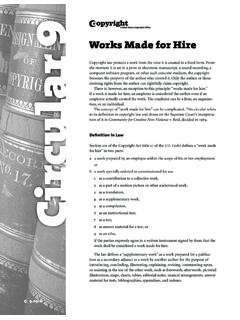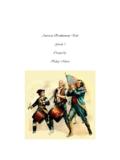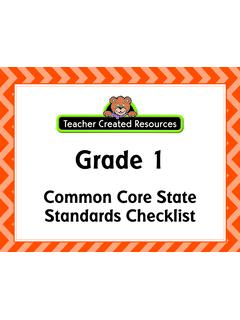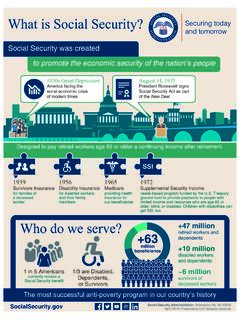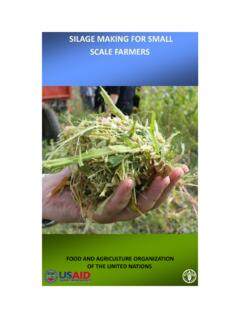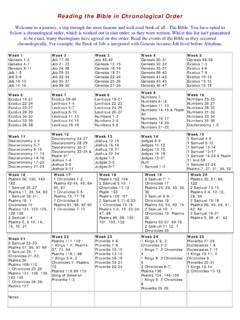Transcription of Georgia Standards of Excellence Curriculum Map Mathematics
1 Georgia Standards of Excellence Curriculum Map GSE 8th Grade These materials are for nonprofit educational purposes only. Any other use may constitute copyright infringement. Mathematics Georgia Department of Education Richard Woods, State School Superintendent July 2016 Page 2 of 7 All Rights Reserved GSE Eighth Grade Curriculum Map 1st Semester 2nd Semester Unit 1 (4 5 weeks) Unit 2 (4 5 weeks) Unit 3 (4 5 weeks) Unit 4 (2 3 weeks) Unit 5 (3 4 weeks) Unit 6 (5 6 weeks) Unit 7 (4 5 weeks) Unit 8 (3 4 weeks) Transformations, Congruence and Similarity Exponents Geometric Applications of Exponents Functions Linear Functions Linear Models and Tables Solvi ng Systems of E quations Show What We Know (eva luating) (equations)
2 ALL Plus High School Prep Review These units were written to build upon concepts from prior units, so later units contain tasks that depend upon the concepts addressed in earlier units. All units will include the Mathematical Practices and indicate skills to maintain. NOTE: Mathematical Standards are interwoven and should be addressed throughout the year in as many different units and tasks as possible in order to stress the natural connections that exist among mathematical topics. Grades 6-8 Key: NS = The Number System F = Functions EE = Expressions and Equations G = Geometry SP = Statistics and Probability. Georgia Department of Education Richard Woods, State School Superintendent July 2016 Page 3 of 7 All Rights Reserved Georgia Standards of Excellence Eighth Grade Mathematics Curriculum Map Rationale Unit 1: This unit centers around geometry Standards related to transformations both on and off the coordinate plane translations, reflections, rotations, and dilations.
3 Students develop understanding of congruence and similarity using physical models, transparencies, or geometry software, and learn to use informal arguments to establish proof of angle sum and exterior angle relationships. Unit 2: Students explore and understand numbers that are not rational (irrational numbers) and approximate their value by using rational numbers. Students work with radicals and express very large and very small numbers using integer exponents. Unit 3: Students extend their work with irrational numbers by applying the Pythagorean Theorem to situations involving right triangles, including finding distance, and will investigate proofs of the Pythagorean Theorem and its converse. Students solve real-world problems involving volume of cylinders, cones, and spheres.
4 Unit 4: Students are introduced to relations and functions. Students define, evaluate, and compare functions. Functions are described and modeled using a variety of depictions, including algebraic representation, graphic representation, numerical tables, and verbal descriptions. Unit 5: Students further explore functions, focusing on the study of linear functions. Students develop understanding of the connections between proportional relationships, lines, and linear equations, and solve mathematical and real-life problems involving such relationships. Slope is formally introduced, and students work with equations for slope in different forms, including comparing proportional relationships depicted in different ways (graphical, tabular, algebraic, verbal).
5 Unit 6: Students extend the study of linear relationships by exploring models and tables to describe rate of change. The study of statistics expands to bivariate data, which can be graphed and a line of best fit determined. Unit 7: The final unit broadens the study of linear equations to include situations involving simultaneous equations. Using graphing, substitution, and elimination, students learn to solve systems of equations algebraically, and make applications to real-world situations. Georgia Department of Education Richard Woods, State School Superintendent July 2016 Page 4 of 7 All Rights Reserved GSE Eighth Grade Expanded Curriculum Map 1st Semester Sta ndards for Math ematical Practice 1 Make sense of problems and persevere in solving them.
6 2 Reason abstr actly and quantitatively. 3 Constr uct viable arg uments and critique the reasoning of others. 4 Model with mathematic s. 5 Use appropriate tools strategically. 6 Atte nd to precision. 7 Look for and make use of str ucture . 8 Look for and expre ss regularity in re peated reasoning. Unit 1 Unit 2 Unit 3 Unit 4 Transformations, Congruence and Similarity Exponents Geometric Applications of Exponents Functions Understand congruence and similarity using physical models, tr ansparencies, or geometry software. Verify experimentally the congruence properties of rotations, reflections, and translations: lines are taken to lines and line segments to line segments of the same length; angles are taken to angles of the same measure; parallel lines are taken to parallel lines.
7 Underst and that a two- dimensional figure is congru ent to another if the second can be obtained fro m the first by a sequence of ro tations, re flections, and translations; given two congru ent figure s, describe a sequence that exhibits the congru ence between them. Describe the effect of dila tions, translations, ro tations and reflections on two- dimensional figure s using coordinates. Underst and that a two- dimensional figure is simila r to another if the second can be obtained fro m the first by a sequence of ro tations, re flections, translations, and dilations; given two simila r two- dimensional figure s, describe a sequence that exhibits the simila rity between them. Use informal arg uments to establish facts about the angle sum and exterior angle of tri angles, about the angles created when para llel lines are cut by a transversal, and the angle-a ngle crit erion for simila rity of tri angles.
8 Work with radicals and integer exponents. Know and apply the pro perti es of integer exponents to generate equivalent numerical expre ssions. Use square root and cube root symbols to represent solutions to equations. Recognize that x = p (where p is a positive rational number and lxl < 25) has 2 solutions and x = p (where p is a negative or positive rational number and lxl < 10) has one solution. Evaluate square roots of perfect squares < 625 and cube roots of perfect cubes > -1000 and < 1000. Use numbers expressed in scientific notation to estimate very large or very small quantities, and to express how many times as much one is than the other. For example, estimate the population of the United States as 3 108 and the population of the world as 7 109, and determine that the world population is more than 20 times larger.
9 Add, subtract, multiply and divide numbers expressed in scientific notation, including problems where both decimal and scientific notation are used. Understand scientific notation and choose units of appropriate size for measurements of very large or very small quantities ( use millimeters per year for seafloor spreading). Interpret scientific notation that has been generated by technology ( ca lculators). Understand and apply the Pythagorean Theorem. Explain a proof of the Pythagorean Theore m and its converse. Apply the Pythagorean Theore m to determine unknown side lengths in right tri angles in real-world and mathematical problems in two and thre e dimensions. Apply the Pythagorean Theore m to find the dist ance between two points in a coordinate system.
10 Solve real-world and mathematical problems involving volume of cylinders, cones, and spheres. Apply the formulas for the volume of cones, cylinders, and spheres and use them to solve real-world and mathematical problems. Work with radicals and inte ger exponents. Use square root and cube root symbols to represent solutions to equations. Recognize that x = p (where p is a positive rational number and lxl < 25) has 2 solutions and x = p (where p is a negative or positive rational number and lxl < 10) has one solution. Evaluate square roots of perfect squares < 625 and cube roots of perfect cubes > -1000 and < 1000. Define, evaluate, and compare functions. Underst and that a function is a ru le that assigns to each input exactly one output. The gra ph of a function is the set of ord ere d pairs consisting of an input and the corresponding output.










